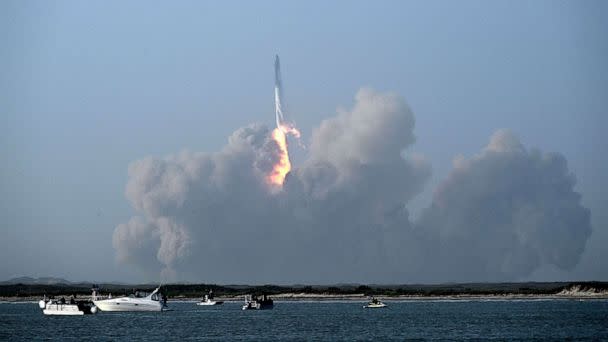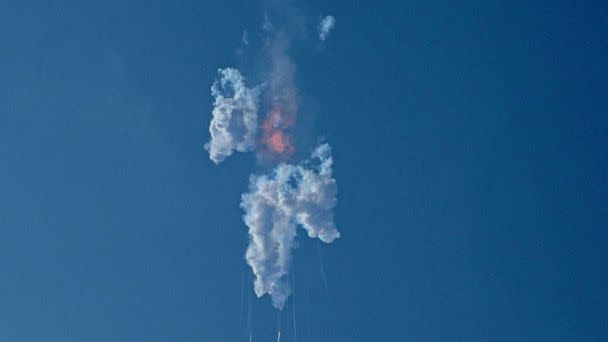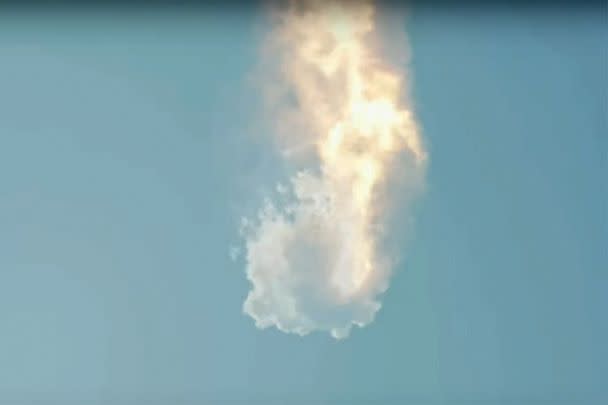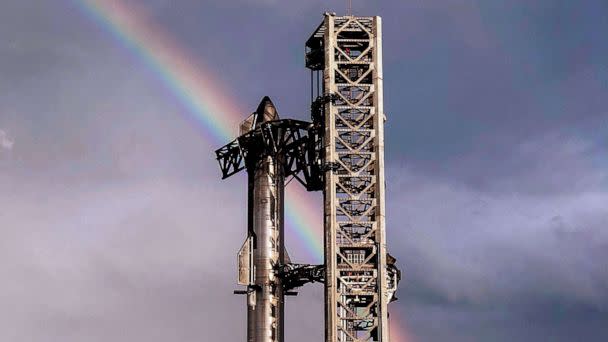SpaceX launch: System forced Starship to self-destruct after it went off course
SpaceX attempted a second launch of its Starship rocket Thursday morning after the first launch attempt was scrubbed due to a frozen valve in the pressurization system.
The launch took place at the company's Starbase facility in Boca Chica, Texas, about 20 miles east of Brownsville. The rocket was forced to self-destruct minutes after liftoff when the boosters failed to separate.
Latest Developments
Apr 20, 3:26 PM
SpaceX confirms it triggered 'flight termination system'
Space X confirmed Thursday afternoon it triggered Starship's flight termination system after the boosters failed to separate.
Starship was veering off its planned trajectory, the company said. SpaceX and FAA have procedures in place to keep a rocket from injuring people or damaging property.
“Starship gave us quite a show during today’s first flight test of a fully integrated Starship and Super Heavy rocket from Starbase in Texas," SpaceX said in statement.

The company said multiple engines were out and therefore the shuttle began to lose altitude and "tumble."
"The flight termination system was commanded on both the booster and the ship. As is standard procedure, the pad and surrounding area was cleared well in advance of the test," the statement read.
SpaceX has not yet announced if or when it will be holding a briefing on the incident.
-ABC News' Gina Sunseri
Apr 20, 11:40 AM
FAA investigating Starship explosion
The Federal Aviation Administration is investigating the explosion of SpaceX's Starship that occurred a few minutes after liftoff.
The agency is responsible for protecting Americans during commercial space transportation launch and reentry operations.

"An anomaly occurred during the ascent and prior to stage separation resulting in a loss of the vehicle," the FAA said in a statement. "No injuries or public property damage have been reported."
"The FAA will oversee the mishap investigation of the Starship/Super Heavy test mission. A return to flight of the Starship/Super Heavy vehicle is based on the FAA determining that any system, process, or procedure related to the mishap does not affect public safety. This is standard practice for all mishap investigations."
SpaceX said the rocket's boosters did not properly separate following the launch.
-ABC News' Gina Sunseri
Apr 20, 10:35 AM
Elon Musk says next launch will be in 'a few months'
SpaceX CEO Elon Musk congratulated the team in a tweet and said the next launch would be later this year, but didn't give any specific dates.
"Congrats SpaceX team on an exciting test launch of Starship!" Musk tweeted. "Learned a lot for next test launch in a few months."
Musk also shared a video of the Starship rocket right after liftoff.
Apr 20, 5:52 PM
SpaceX congratulates team even after rocket self-destructs
SpaceX congratulated the team behind the Starship rocket launch, even after it was forced to self-destruct when the boosters failed to separate.
"With a test like this, success comes from what we learn, and today’s test will help us improve Starship’s reliability as SpaceX seeks to make life multi-planetary," SpaceX tweeted.

"Congratulations to the entire SpaceX team on an exciting first integrated flight test of Starship!"
SpaceX said the team will be reviewing the data and working towards its next launch attempt.
Apr 20, 9:50 AM
Starship boosters fail to separate from shuttle, rocket blown up
SpaceX was able to get its Starship rocket off the pad, but all didn't go as planned.
About three minutes into flight, "Starship experienced a rapid unscheduled disassembly before stage separation," SpaceX tweeted.
Therefore, SpaceX was forced to abort the mission and blow up the rocket, but the team says it's more of "success" than they hoped for.
Apr 20, 9:39 AM
Starship launches into space
Starship launched at 9:33 a.m. ET, just five minutes after the launch window opened, on its inaugural flight.
The shuttle is currently the largest spacecraft in the world at about 393 feet and is expected to eventually carry passengers to the moon and Mars in a similar vein to NASA's Artemis mission.
Starship is designed to carry up to 100 people on long-duration, interplanetary flights.
Apr 20, 9:23 AM
What Starship's journey will look like
For this first flight test, SpaceX said Starship will not attempt a vertical landing of Starship or a catch of the booster.
If successful, Starship and its rocket, which is called Super Heavy, will head up to the skies and 33 Raptor engines will ignite simultaneously. About eight minutes after liftoff, Super Heavy will splash down in the Gulf of Mexico.

Meanwhile, the spacecraft will travel about 150 miles -- partially around the Earth -- and then splash down in the Pacific Ocean near Hawaii about 90 minutes after liftoff.
There will be a 62-minute window opening at 9:28 a.m. ET. A live webcast began 45 minutes before liftoff.
Apr 20, 8:45 AM
Starship rocket is being loaded
SpaceX is fueling its Starship rocket -- the world's larger spacecraft -- as it attempts a second launch.
The first launch attempt was scrubbed Monday due to a frozen valve in the pressurization system.
"The Starship team is go for prop load; team is keeping an eye on the weather," SpaceX said in a tweet.
